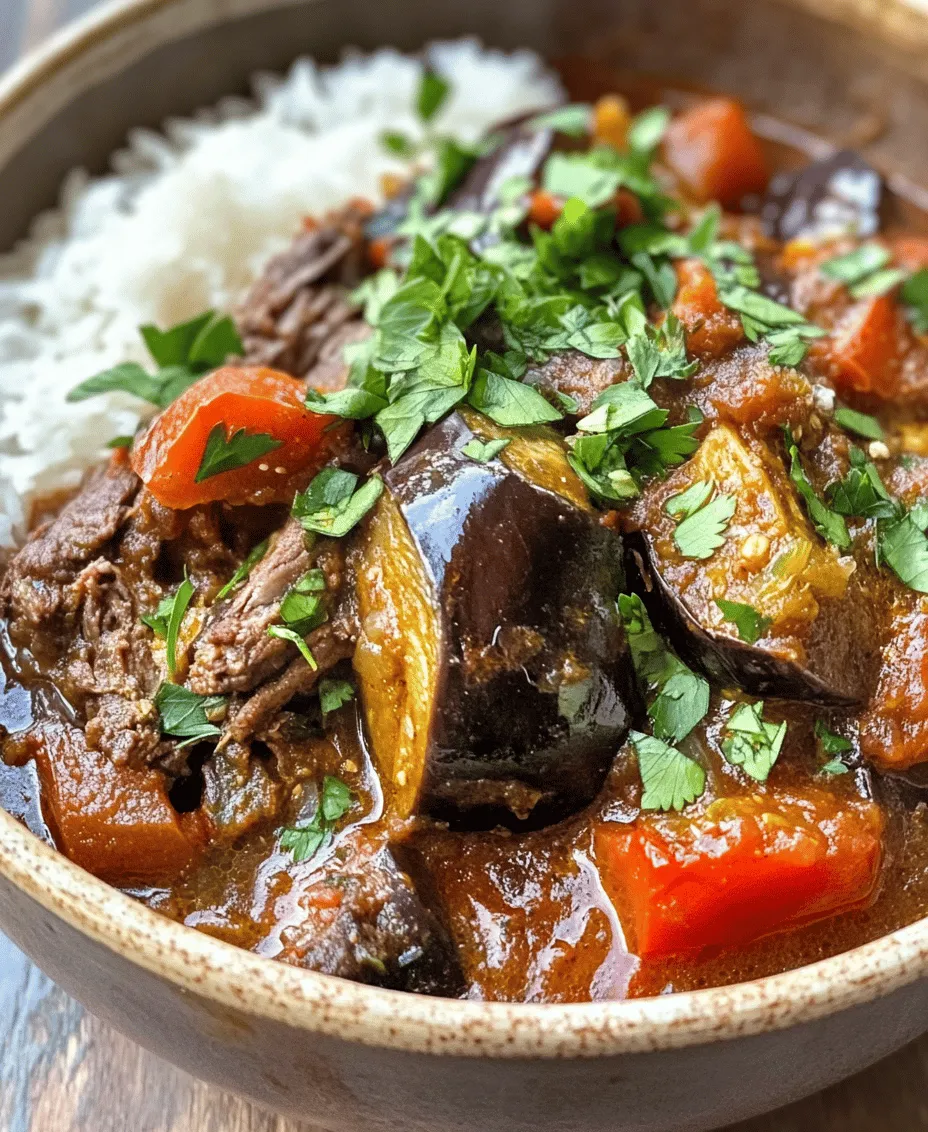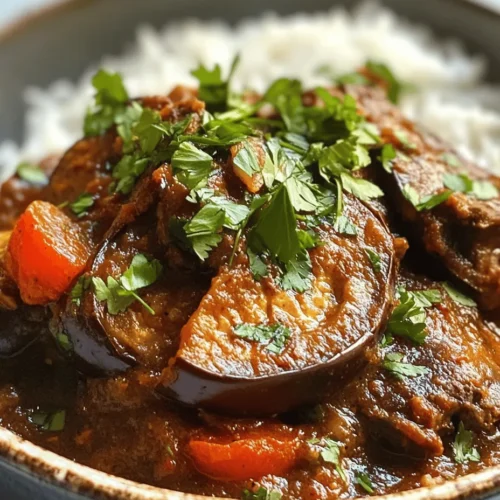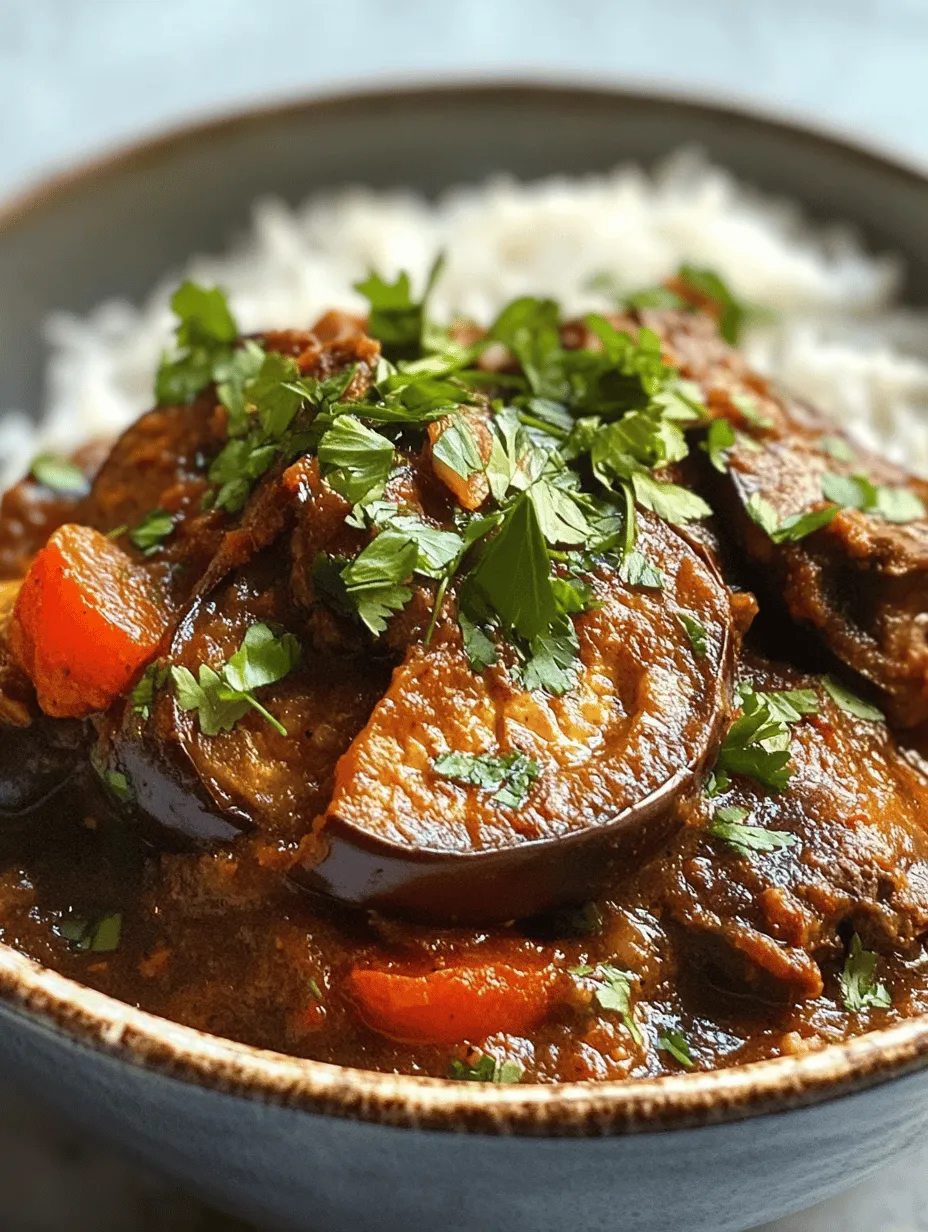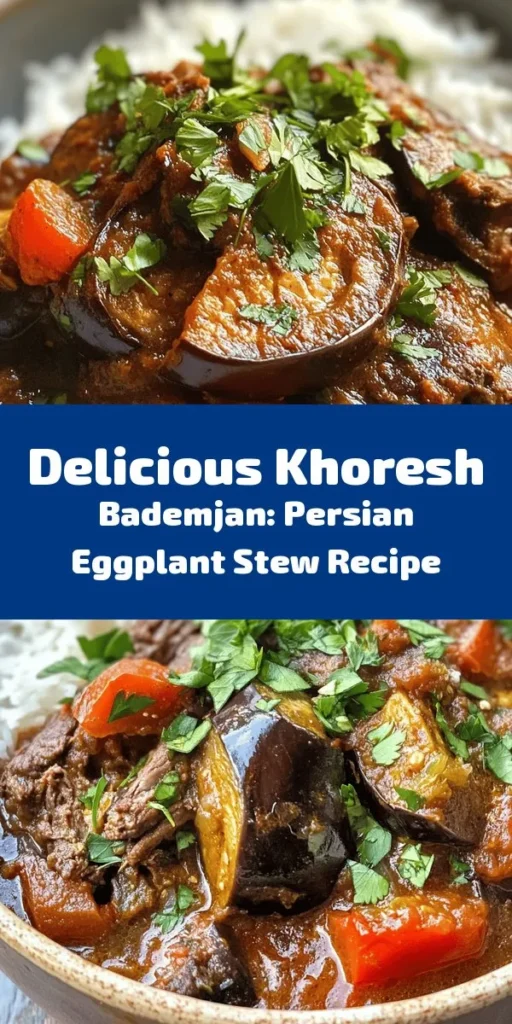Introduction
Khoresh Bademjan is one of the many gems that showcase the rich tapestry of Persian cuisine. This delightful eggplant stew is a harmonious blend of flavors, textures, and aromas that transport you to the bustling bazaars of Iran with every bite. Traditionally made with succulent pieces of meat, often lamb or beef, and complemented by tender eggplants, Khoresh Bademjan is not just a meal; it is a comforting experience that embodies the essence of Persian hospitality.
The heart of this dish lies in its ability to balance the savory depth of meat with the subtle bitterness of eggplants, all while being elevated by a carefully curated selection of spices. In this article, we will delve into the ingredients, preparation methods, and cultural significance of Khoresh Bademjan, equipping you with the knowledge necessary to create this traditional dish in your own kitchen.
Understanding Khoresh Bademjan
The Cultural Significance of Khoresh Bademjan
Khoresh Bademjan is more than just food; it’s a reflection of Persian culture and its culinary traditions. In Iran, khoresh (which means stew) is a common part of daily life and is often served alongside fluffy, aromatic basmati rice. This particular stew holds a special place in the hearts of many, often featured on festive occasions and family gatherings.
The dish symbolizes a gathering of family and friends, where the act of sharing a meal fosters connection and community. Moreover, the cooking process itself is a ritual of love and care, as each ingredient is thoughtfully prepared to contribute to the overall flavor and character of the stew.
The Role of Eggplants in Persian Cuisine
Eggplants, or “bademjan,” are not just an ingredient in this dish; they are a cornerstone of Persian cooking. Their unique flavor and texture allow them to absorb the spices and other flavors in a dish, making them incredibly versatile. In addition to Khoresh Bademjan, eggplants are used in various Persian recipes, such as Mirza Ghasemi and Baba Ganoush, each showcasing their ability to shine in different culinary contexts.
In Persian culture, eggplants are often seen as a symbol of fertility and abundance, further underscoring their importance in traditional dishes. The preparation of eggplants in Khoresh Bademjan is meticulous, as the salting process helps to draw out bitterness, allowing for a more refined taste that complements the savory elements of the stew.
Historical Origins of Khoresh Bademjan
The origins of Khoresh Bademjan can be traced back to ancient Persia, where the use of eggplants and spices flourished. The dish likely evolved over centuries, influenced by the agricultural practices and culinary traditions of the regions that now comprise modern-day Iran. The introduction of eggplants to Persian cuisine is believed to have occurred during the Islamic Golden Age when the vegetable spread across the Middle East and into Europe.
As Persian cuisine absorbed various influences over time, Khoresh Bademjan emerged as a beloved staple, appreciated for its rich flavors and nourishing qualities. The stew’s historical significance is intertwined with the agricultural bounty of the region, showcasing the importance of using fresh, seasonal ingredients in Persian cooking.
Ingredients for Khoresh Bademjan
Creating a delicious Khoresh Bademjan requires a careful selection of ingredients. The following is a comprehensive list of what you’ll need to prepare this delightful Persian stew.
Essential Ingredients for the Stew
1. Eggplants (Bademjan): The star ingredient, typically long, slender varieties are preferred for their flavor and texture.
2. Meat: Traditionally, lamb or beef is used, cut into bite-sized pieces. For a vegetarian version, chickpeas serve as an excellent substitute.
3. Onions: Essential for building the flavor base, they are usually finely chopped.
4. Tomatoes: Fresh or canned tomatoes add acidity and sweetness to the stew.
5. Lemon Juice: Freshly squeezed lemon juice adds brightness and balances the richness of the dish.
6. Turmeric: A staple in Persian cooking, turmeric infuses the dish with a warm, earthy flavor and a vibrant yellow color.
7. Cinnamon: Adds a subtle warmth and depth to the stew, enhancing its complexity.
8. Salt and Pepper: Essential for seasoning the dish to taste.
9. Water or Broth: Used to create the stew’s base, adding moisture and richness to the final dish.
Overview of Spices and Their Flavor Profiles
The spices used in Khoresh Bademjan are what elevate it from a simple stew to a culinary masterpiece. Here’s a deeper look at the key spices:
– Turmeric: Often referred to as “Persian gold,” turmeric is known for its anti-inflammatory properties and earthy flavor. It forms the backbone of many Persian dishes, providing both color and taste.
– Cinnamon: This warm spice adds a hint of sweetness and complexity to savory dishes. In Khoresh Bademjan, it balances the richness of the meat and eggplant.
– Black Pepper: Provides a subtle heat that enhances the flavors of the other ingredients without overpowering them.
– Lemon Juice: Though not a spice, the acidity from lemon juice is crucial in cutting through the richness of the stew, providing a refreshing contrast.
Vegetarian Adaptation: Chickpeas as a Substitute
For those seeking a vegetarian or vegan option, chickpeas can be substituted for meat in Khoresh Bademjan. Not only do they add protein, but they also absorb the flavors of the spices and sauce beautifully. To prepare the vegetarian version, simply follow the same steps as the traditional recipe, allowing the chickpeas to simmer until tender and infused with the rich flavors of the stew.
Preparation Steps for Khoresh Bademjan
Now that we have a clear understanding of the ingredients, let’s dive into the preparation steps for Khoresh Bademjan. This section will guide you through the essential techniques needed to create a perfectly balanced and flavorful stew.
Preparing the Eggplants: The Salting Process
The first step in preparing Khoresh Bademjan is to properly prepare the eggplants. This is crucial to achieving the desired texture and flavor. Begin by slicing the eggplants into thick rounds or long strips, depending on your preference.
Once sliced, place the eggplant pieces in a colander and generously sprinkle them with salt. The salting process serves two main purposes: it draws out excess moisture and eliminates any bitterness that eggplants may possess. Allow the eggplants to sit for about 30 minutes. After this period, you will notice beads of moisture forming on the surface of the eggplant.
After the eggplants have sweat, rinse them under cold water to remove the excess salt and bitterness. Pat them dry with paper towels to ensure they are ready for frying.
Frying the Eggplants: Techniques for Perfect Texture
Frying the eggplants is a pivotal step in creating Khoresh Bademjan, as it enhances their flavor and texture. In a large skillet or frying pan, heat a generous amount of oil over medium-high heat. The oil should be hot enough that a small piece of eggplant sizzles when added.
Carefully add the eggplant slices to the hot oil in batches, ensuring not to overcrowd the pan. Fry them until they are golden brown and tender, about 3-4 minutes per side. The goal is to create a beautiful sear while maintaining a creamy interior.
Once fried, transfer the eggplants to a plate lined with paper towels to absorb any excess oil. This step is important to keep the dish from becoming too greasy and allows the eggplants to retain their shape in the stew.
Sautéing Onions and Garlic: Building a Flavor Base
With the eggplants prepared, it’s time to build the flavor base of Khoresh Bademjan. In the same skillet used for frying the eggplants, add a bit more oil if necessary and reduce the heat to medium. Add the finely chopped onions and sauté them until they are translucent and lightly golden, about 5-7 minutes.
Next, add minced garlic to the onions and sauté for an additional minute until fragrant. This combination creates a wonderfully aromatic foundation for the stew, ensuring that every bite is packed with flavor.
Once the onions and garlic are perfectly sautéed, it’s time to incorporate the meat (or chickpeas for the vegetarian version) into the skillet. Stir to combine, allowing the meat to brown slightly and absorb the flavors from the onions and garlic.
As you continue with the recipe, you will layer in the remaining ingredients, including spices, tomatoes, and the fried eggplants, leading to the final cooking stage where all the flavors meld together beautifully.
With these initial steps, you are well on your way to crafting a memorable Khoresh Bademjan. Stay tuned for the next part of the recipe, where we will cover the remaining steps to create this beloved Persian dish.

Cooking the Meat: Browning for Depth of Flavor
To begin crafting your Khoresh Bademjan, it’s essential to start with the meat, as browning it properly will lay the foundation of deep, rich flavors in your stew. Heat about 2 tablespoons of vegetable oil in a large pot or Dutch oven over medium-high heat. Once the oil is shimmering, add your cubed lamb or beef. It’s important not to overcrowd the pan; if necessary, brown the meat in batches.
Sear the meat for about 5-7 minutes until it develops a beautiful golden-brown crust on all sides. This browning process is crucial as it enhances the stew’s flavor through the Maillard reaction, creating complex savory notes. Once browned, remove the meat from the pot and set it aside.
Adding the Spices: Enhancing the Stew’s Aroma
With the meat removed, it’s time to build layers of flavor through the spices. In the same pot, add a finely chopped onion and sauté for about 5 minutes until they become translucent. This process releases the natural sugars in the onion, which will contribute to the stew’s sweetness.
Next, add minced garlic and a combination of spices. Traditional Khoresh Bademjan typically includes ground turmeric, cumin, and black pepper. Stir these spices into the onions and garlic, cooking for an additional 1-2 minutes until fragrant. This step is essential as it wakes up the spices, allowing their oils to release and infuse the dish with their aromatic profiles.
Incorporating Tomatoes and Broth: Creating the Stew Base
Once your spices are aromatic, it’s time to return the browned meat to the pot. Next, incorporate 2-3 tablespoons of tomato paste, stirring well to coat the meat and onions evenly. The tomato paste will provide acidity and depth, balancing the flavors in the stew.
Following this, add chopped tomatoes (canned or fresh) and about 4 cups of beef or vegetable broth. The broth serves as the liquid base for your stew, ensuring that all ingredients meld together beautifully. Bring the mixture to a gentle boil, then reduce the heat to low, allowing it to simmer. This slow cooking process is vital in ensuring that the meat becomes tender and the flavors meld seamlessly.
Combining Ingredients: The Role of Dried Limes
As the stew simmers, it’s time to enhance its flavor further by incorporating dried limes, known as “limoo amani.” These limes add a unique tangy flavor to the dish. Pierce them a few times with a knife or fork to allow the flavors to infuse into the stew more effectively. Add 2-3 dried limes to the pot, ensuring they are submerged in the broth.
Allow the Khoresh Bademjan to simmer uncovered for about 1.5 to 2 hours. This cooking time is critical as it allows the meat to soften and the flavors to develop. Stir occasionally, and if the stew thickens too much, you can add a little more broth or water to reach your desired consistency.
Slow Cooking: Achieving Tenderness and Flavor Integration
The essence of Khoresh Bademjan lies in its slow-cooked nature. As the stew simmers, the eggplants will absorb the flavors of the broth while becoming incredibly tender. For the eggplants, slice them into thick pieces, about 1-inch thick, and sprinkle with salt. Let them sit for about 30 minutes to draw out excess moisture and bitterness.
After resting, rinse the eggplant slices under cold water and pat them dry with paper towels. In a separate skillet, heat some oil over medium heat and fry the eggplant slices until they are golden brown on both sides, about 3-4 minutes per side. This step not only enhances their flavor but also helps retain their shape in the stew.
Once the eggplants are ready, add them to the pot with the meat and broth. Cover and continue to simmer for another 30 minutes. The slow cooking process allows the eggplants to absorb the stew’s flavors while becoming velvety in texture.
Serving Suggestions
Traditional Accompaniments: Basmati Rice and Flatbreads
Khoresh Bademjan is traditionally served with fluffy basmati rice, which complements the stew beautifully. The rice not only balances the rich flavors of the stew but also acts as a perfect vessel for the savory sauce. To prepare the rice, rinse about 2 cups of basmati rice under cold water until the water runs clear. Soak the rice for at least 30 minutes before cooking to achieve a fluffy texture.
When you’re ready to serve, cook the rice in a pot of boiling salted water for about 10-12 minutes or until the grains are tender but still firm. Drain the rice and let it steam for a few minutes before fluffing it with a fork. Serve the Khoresh Bademjan over a generous mound of basmati rice.
In addition to rice, you can serve Khoresh Bademjan with warm, pillowy flatbreads, such as lavash or pita, which are perfect for soaking up the delicious sauce.
Garnishing for Presentation: The Importance of Fresh Parsley
To elevate the presentation of your Khoresh Bademjan, consider garnishing it with freshly chopped parsley or cilantro just before serving. This addition not only adds a vibrant color contrast but also brings a fresh flavor that brightens the overall dish. A sprinkle of toasted slivered almonds can also add a delightful crunch.
Pairing with Side Dishes: Complements to Khoresh Bademjan
Khoresh Bademjan pairs wonderfully with various side dishes. A simple cucumber and tomato salad drizzled with lemon juice and olive oil can provide a refreshing counterbalance to the rich stew. You may also consider serving pickled vegetables, known as “torshi,” which add a tangy bite that complements the dish perfectly.
Nutritional Information
Caloric Breakdown of Khoresh Bademjan
A serving of Khoresh Bademjan (approximately 1 cup) contains around 350-400 calories, depending on the meat used and the amount of oil added. The calorie count may vary slightly if you opt for a vegetarian version, which typically has fewer calories.
Health Benefits of Key Ingredients
Khoresh Bademjan is not only delicious but also packed with nutrients. Eggplants, the star ingredient, are low in calories and rich in fiber, vitamins, and minerals. They are also a good source of antioxidants, which help combat oxidative stress in the body. The inclusion of meat provides protein, iron, and essential amino acids, while herbs and spices contribute anti-inflammatory properties.
Vegetarian vs. Meat Versions: Nutritional Comparisons
If you prefer a vegetarian version of Khoresh Bademjan, simply replace the meat with hearty vegetables like mushrooms or chickpeas. This alternative not only makes the dish lighter but also increases its fiber content. A vegetarian Khoresh Bademjan will generally have a lower calorie count and be suitable for those looking for plant-based options.
Conclusion
Khoresh Bademjan is more than just a meal; it is a celebration of Persian culinary heritage. With its layered flavors and hearty ingredients, this stew offers a comforting dish suitable for any occasion. By following the steps outlined in this article, you can bring a taste of Persia to your dining table, creating a dish that is not only delicious but also steeped in tradition.
The journey of preparing Khoresh Bademjan allows you to explore a rich tapestry of flavors, from the tender meat and velvety eggplants to the fragrant spices that permeate the stew. Enjoy the journey of cooking and savor every bite of this exquisite eggplant stew. Whether served on a festive occasion or a cozy family dinner, Khoresh Bademjan is sure to impress and leave everyone craving more.



